Lefkara lace, from Cyprus, has become a fascinating subject of study for me the last couple weeks, ever since Elissa sent me photos from her Cyprus adventures. The other day, I showed you a few brief bits of Lefkara lace, hoping to whet your appetite for the subject, too. I think what fascinates me most about the technique is that it strikes me, too, as a combination of Italian needle lace and Hardanger, with a little Schwalm thrown in along the edges. The Venetian influence on Lefkara lace is easy enough to understand, as Venice had administrative control of Cyprus some 500-ish years ago. Sources seem to be in conflict over whether Venice brought the lace technique to Cyprus, or Cyprus sent it back to Venice. I’ll have to do a little more research on that one!
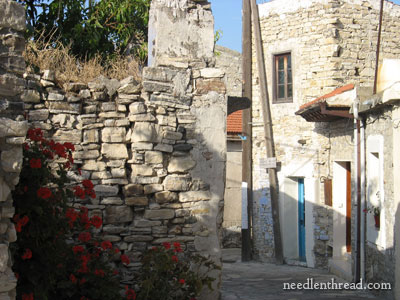
What I do know is that along the narrow streets of this little town, once there was a booming lace industry. Ladies worked in the sun outside their homes and shops, and they passed their skills down to the next generation. In the 1930’s, and with the dawn of World War II, this all changed.
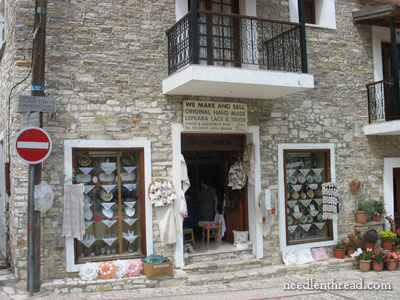
Today, in Lefkara, there are still some lacemakers and shops that sell the lace. There are also organizations striving to keep Lefkara lacemaking alive by marketing the embroidery to people around the world via the internet. One such organization is called the Lefkara Handicraft Center, and on their website, you will find further information about the history of the technique, what’s going on with it today, the ladies who still make Lefkara lace, and also how to buy Lefkara lace goods (table cloths, table runners, and so forth).
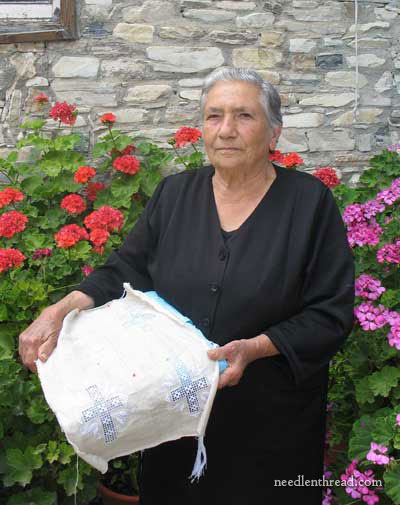
The ladies who make Lefkara lace often work together on large pieces, or they specialize in certain parts of the lace-making process. Right now, a group of ladies is preparing for the Papal visit to Cyprus later this year, by working together on a cloth for the Pope. Evdokia is one of the lace makers. She’s the aunt of the lady who runs the Lefkara Handicraft Center website and cooperative. My “correspondent in the field” (Elissa) was able to work with Evdokia to learn a little bit about Lefkara lace-making. What an opportunity!
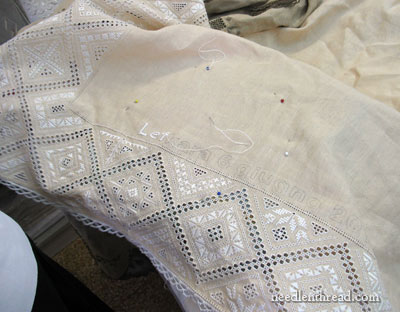
The cloth above is the piece being prepared for the Papal visit. The linen is a cream color with white threads for the embroidery. Once upon a time, the linen used in Lefkara lace was produced on Cyprus, but now they use a sturdy Irish linen. Common colors used for Lefkara lace are cream, white, and a natural / brownish color.
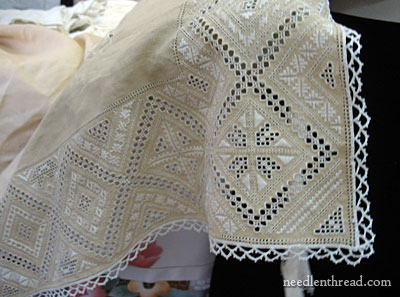
This is the edge of the same cloth. It’s quite beautiful!
Next time we visit Lefkara lace, I’ll show you some close up photos of the different motifs used in the lace making process.
Have you ever heard of Lefkara lace? It’s something that I would like to learn more about, but resources are somewhat scarce. If you have any ideas or any input on where to find information on the subject, please leave a comment below and let me know!







it is the first time to know the name of this art , but i saw it before .
i will try to know more about it and send you any informations about it . thank you and forgive me for my bad English.
vraiment beau
du talent
je vous admire
Ooh, very pretty. I usually don’t like drawn thread work, but that is very elegant. Is that tatting around the edges?
As I said in a previous letter I do have a book with good instructions. One I purchased from Barbara Fey Bookseller. The Euro is good right now, so it would be a good time to buy. Have done samples of the technique and am just barely started on a piece.Very interesting!!!!! Just lovely stuff. Have made a study of Whitework Techniques for about the last 7 years. Have all the Schwalm Books you have mentioned in your blogs and had to translate for myself . Also, have all the Punto ANtico Books and some on Reticelli. I taught Ukrainian Whitework for a long while and just worked up designs from the books that came out of the Ukraine–couldn’t read the language but the pictures were easy to see and understand. Did the same with the Italian books. Kept me out of the Bars and Casinos. Rena.
I haven’t heard of Lefkara lace, but your article lead me to google schwalm, which lead me to look up hedebo. I don’t have much experience with embroidery other than drawn, pulled and counted thread, which makes this lace all the more interesting, because it is the kind of thing I like to do. Beautiful!
Mary
Thank you for expanding on this lace. It is beautiful. I have done lots of Hardanger and Drawn Thread work but this lace goes beyond anything I have done. I hope to find patterns and books for this type of embroidery. I was amazed to hear that it is reversible. I would love to know how they do that!!!!!!!
Thanks for these 2 posts, Mary! I do think Lefkara is wonderful. Years ago (back in the 90’s!), I beleive it was the magazine Treasures in Needlework that did an article on Lefkara with TONS of pictures. This was the first time I had seen this wonderful work. I’ll have to dig through my magazine stash to see if I can find the issue and will add the correct information when located.
Very interesting. It appears to have a lot in common with Hardanger, although perhaps it is somewhat less structured.
After your post a couple of days ago I tried some googling of my own; from what I can find there seems to be some confusion among people not that familiar with embroidery where any and all embroidery produced in Lefkara are labeled “Lefkara Lace.”
It would appear however that the true samples of the craft are those with the Hardanger-like appearance, both in terms of the drawn threads and the satin stitch figures.
Wiki tells me that “The exact origins of Hardanger embroidery are not known but it is thought to have its beginnings in ancient Persia and Asia. During the Renaissance this early form of embroidery spread to Italy where it evolved into Italian Reticella and Venetian lacework. By 1700 variations of this type of embroidery had spread to northern Europe where it developed further into Danish and Dutch Hedebo, Scottish Ayrshire work and Ruskin lacework as well as Norwegian Drawn Work, as it was then called.”
By that token (and as always we need to take Wiki with a pinch – or six – of salt) it would appear that Lefkara Lace and Hardanger share a common ancestry, joint possibly up to the Venetian connection before diverging.
I would be interested to see some comparison and contrast between Hardanger and Lefkara Lace.
– Sivani (who is subject to a Hardanger and Blackwork obsession just now)
Lefkara Lace Embroidery by Androula Hadjiyiasemi, 1987
ISBN 9963-7643-1-2
Mary, I have this book which was a gift to me from Elisabetta Holzer of all people!! She had a friend who was going to Cyprus get it for me. It has English text and some 200 pages. Lots of how-to pics and lots of pics of embroideries.
You can order it from Tombolo Disegni in Italy by sending an email request, Gianfranca will then send you a PayPal request. She has this book listed for 37 euros but it’s heavy so I think the shipping might be expensive. You could always ask.
http://www.tombolodisegni.it/
Click on “Libri/Books” then “Sfilati ed Assia” – it’s near the bottom of the page.
Also Christine P. Bishop wrote an article for Embroidery & Cross Stitch magazine (Australian mag) Vol. 8 No. 2 Jan 2002 – Threads of the Past – Lefkara – just history, no project. Lovely pics!
http://www.angelfire.com/wizard/embroidery/published.html
Ciao!
Jeanine in Canada
p.s. when I wrote my article on Punto Antico for Piecework, I suggested that Punto Antico was probably an ancestor of Hardanger… they edited it out. The Venetians and before them the Romans were everywhere! Chances are if they didn’t bring techniques from home, they transported techniques from country to country in goods and slaves!
Hi Mary. At first glance I thought it was very similar to hardanger. On second glance its only part like that. The drawn thread gives it a lighter/airy look if you know what I mean..Vey elegant as was commented above.
And dont you just love those very very old towns they have in Europe. If only those walls could talk.
Down here at the bottom of the world our European history is very young and we dont have all the lovely ancient old buildings.
Regards
Phillipa
Gracias por compartir los viejos edificios de Lekfara en Chipre y las maravillosas labores que estas damas han elaborado, son hermosos.
Very interesting. I had never heard about this stitching technique
I love the how to videos. I have had a difficult time comprehending the shadow stitch. It would be helpful for me to see it on a video so that I could replay it over and over until I finally got it!! Great website, glad I found it!!
G’day there Mary,
“Home is the sailor,home from the sea,
And the hunter home from the hills”. (or something like that)
And I am home from the west and away from my little bush princess grand daughter. Well, if I don’t leave I can’t go back eh.
Now, I’ve had peeps at a few posts but will just start my comments 2day.
This lace is precious. Now that you have definitely got my attention with it and I’ve looked up the site you gave I feel I’ll never forget it.
I’m taken too, with the women’s faces. There is more goes into this lacemaking than needle, thread and following designs. There are thoughts that will never be revealed nor understood by the many who simply admire the embroiderer’s work. I suppose that is so to some degree with all such things, but this has an extra something to it for me.
Thank you again for opening doors for this interested armchair traveller.
Cheers, Kath
Mary, I too am a lucky owner of the Lefkara Lace Embroidery Book after taking a class here in Sydney Australia with Christine Bishop. She organised some of the books to be sent over for her students. She specialises in Schwalm embroidery and has published books on same, this seems to be closely related to Schwalm as well as Reticella and other withdrawn thread embroidery/laces. I loved doing it though I’m not too good on picots !!
Oh boy, one more thing to ‘have’ to do. I do Hardanger now and so I CAN justify learning this too (well in my mind I can :). This lace is gorgeous and the piece they’re working on for the Pope is just incredible! Thank you so much for introducing me to this type of lace.
Interesting Site being built
Kato Lefkara is UNIQUE for its lace and being a special village
The Cyprus hand-made lace created in the same village for several hundred years is known as lefkaritiko, indigenous to the village of Lefkara, in Larnaka district, has now been officially added to the Representative List of the Intangible Cultural Heritage of Humanity of UNESCO in 2009.
This is ‘The Lefkara’ the original epi-centre of lace, ‘Kato Lefkara’ visited by Leonardo da Vinci who bought the cover for Milan Cathedral’s altar after a personal visit to Lefkara in 1481
Historic churches with wonderful old frescos, cobbled streets, wonderfull architecture and archways with places to tether the horses. A village that expanded during the Venetian period 1489-1571. You can dream as you stroll of times gone
Lefkara lace knots. I have the only book on the lace but am having difficulty with the knots – the instructions on p113 are not clear. It seems you make 3 knots using either your thumb or a needle to position the knots. It then says ‘The needle is then inserted into the loop of the knot and moved towards the point where the knot is required’. ????? This part is not illustrated. The book says you only use a button hole stitch before and after making a knot when you are using overstitch for binding. Can you help please? –
Hi, Maureen – Well, I don’t have the book, and I’m not 100% sure what’s being described here, but I would imagine that they mean that you are supposed to pass the needle back into the loop formed by the knots, situating the knot cluster where you want it and then passing into the main work again, to make a buttonhole stitch to secure it. Again, I’m not 100% certain, as I’d have to see the whole set of directions. You’re welcome to e-mail if you’d like (use the contact link in the website footer), and I’ll see if I can help further! ~MC
hi Mary, although a non-Cypriot myself (Greek nevertheless) I know well the technique of Lefkara embroidery. You see it has the same base with Hardanger. Don’t ask me how those two nations met to exchange techniques. As far as I know the technique of Lefkara embroidery was picked up by Venice. An example of my similar to Lefkara embroidery work you can see here >
http://lifebookmarks.blogspot.com/search/label/%CE%94%CE%97%CE%9C%CE%99%CE%9F%CE%A5%CE%A1%CE%93%CE%99%CE%95%CE%A3
Also there is another even more fine technique coming from just one Greek island called Lefkas. This island is located between Greece and Italy. My samples of that technique you can see here >
http://lifebookmarks.blogspot.com/2010/12/h-ginger.html
If you are interested I can give you all info about these techniques. Just drop me an email with your questions and I will be more than glad.
Have a nice day in the meantime!
Thank you, Ginger, for the links! MY GOODNESS – the examples in the links you sent are really gorgeous!! I will take you up on your offer some day, when I get a chance to revisit the subject and try it out. I’m swamped right now with other projects, but this is one technique high on my list for this year.
Thanks heaps!
Mary
COME AND VISIT US
It is said Aphrodite gave the Pomegranate to Cyprus and the Venations brought to Kato Lefkara were Lace is still produced by hand today, Michael Angelo came to purchase lace from Lefkara that has been made for with the same skill and handed down from generation to generation in the same village for centuries – Visit our unique village of Kato Lefkara between Larnaca and Limassol
I have the Lefkara lace embroidery book by Hadjiyiasemi, and two brand new cloths; a table cloth and a tray cloth.
I am no longer able to embroider and I am considering selling my item(s). May you be interested? Dee
Hi Dee,
Do you still have the Hadjiyiasemi? What language is it in? What is the cost? Where are you located? I embroider and am very interested in trying the Lefkara style to keep it alive.
Thanks, Mary
“I will take you up on your offer some day” anytime you decide just contact me. That’s a rain-check…..
What thread count per inch fabric is typically used, and what thread thickness is common for the embroidery?
Some of the edging stitches and picots look like they are “Oya” which is a Mediterranean form of knotted needle lace that is popular in that part of the world (with debate about where it started). It appears to me, that the two techniques (even weave embroidery and cutwork, edged with knotted needlelace) have been merged.
In Oya, the knots are made with a larger needle perpendicular to the work, it is wrapped a certain way (varies sometimes, but there is a basic stitch/wrapping technique) and then a strong tug to knot it. It takes practice to do the knots (picot) well and evenly.
I am curious about the specific gauge of materials used for the Lefkara.
TIA,
Susan
HI, all – Thanks so much for your replies to this post! I find it an interesting topic on two accounts: 1. I’m interested in the techniques; 2. I’m interested in this whole question of the handmade industry, costs, skill, labor, and so forth. I agree with the fact that most of this type of work must be done for a love of the work, more than the idea of making a lot of money from it – yet I believe that this type of “labor” (do you call needlework labor? I think so, especially when it’s done to make a living) deserves to receive a living wage. The difficulty of being paid a fair price for intricate and time-consuming needlework is that the hours involved increase the price so much. A funny example: I was asked to reproduce my “Agnus Dei” project for someone, who said he was willing to pay me an hourly wage and the cost of supplies to do it. At a minimum of $10 / hour, the piece would cost over $4,000. The party involved was aghast! This was because he had no idea how much time is involved in hand embroidery. If I had said $5 / hour, it would have been just over $2,000, and he still would have balked. I asked him what he was willing to pay. He was figuring about $800 for the whole finished thing. This would have worked out to about $1.35 / hour, if supplies were included. So there’s the affordability question on the part of the buyer, but also the fairness of the wage on the part of the maker…..
Susan – I am not quite sure what type, count, etc., of linen is used. I think this subject may have come up in one of my previous posts on Lefkara lace, or in an e-mail correspondence. I’ll see if I can find the answer. If not, I’m assuming it’s in a book somewhere – but I don’t have a book specifically on Lefkara lace. There’s one I’d like to procure, but it’s out of print and quite pricey. If I can find an answer for you, I’ll let you know!
Keli et al. re: Hardanger: Yes, there’s a definite similarity in the geometric parts of the patterns and in the fact that there are many opened spaces with similar fillings. There’s also a strong similarity between Lefkara and the Italian needle laces, too. I think it would be a very interesting study, to see how all these styles are related, how they were introduced to various regions at different points in history, and how they emerge and diverge!
Thanks again for all your input!
~MC
Here is a video on Lefkara lace which suggests Venetian origins:
http://www.unesco.org/archives/multimedia/index.php?s=films_details&id_page=33&id_film=320
For future searchers, the Treasures in Needlework issue mentioned in comment #7 above by Katherine is the Winter 1992 issue and article is by Kit Schlich.
Christine Bishop herself wrote an article on Lefkara for the Australian magazine: Embroidery and Cross Stitch:
Vol 8 No 2 Jan 2002 – Threads of the Past – Lefkara
http://www.angelfire.com/wizard/embroidery/published.html
Hi, I am going to Northern Cyprus in a months time and hope to visit Lefkara and purchase something that has been handmade by the ladies. I was amazed to see it on needlenthreat !
My Yiayia is from Larnaca and my Papou is from Pano Lefkara. Too many years ago I was able to visit. We still have relatives there and they were kind enough to show me how to make this amazing lace. Sadly, I have long since forgotten what I was taught. I still have pieces from my trip and better still, I have pieces handed down over the generations. I would LOVE to re-learn but I have been unable to locate the information on how to.. I would greatly appreciate if anyone has information and would share.
The entire piece is done of drawn work. No tatting or embroidery as I understand it. Breathtaking
Dear Mary
Thank you very much for sharing those beautyful pictures and your experience with us!
I bought during a visit to Cyprus a nice traditional Lefkara Lace tablecloth. It is not machine made, but hand embroidered. I was wondering if it possible to wash it by hand or even in the washing machine, without spoiling the beautyful embroidery (Irish linen should not be the problem, but the French thread used for the embroidery could be damaged):do you have by chance any suggestions?
Looking forward to reading from you!
Kindest regards
Tessa
Hi, Tessa – yes, it should be washable without a problem. The threads are usually cotton. These items are normally made for use, so washing is pretty much expected. Whether or not you wash it by hand or machine is up to you. I’d probably hand wash it, but if it’s a large tablecloth, that might pose a problem. Also, be careful when lifting out of water, if it is large. It’ll be heavy. I don’t think you have to worry so much about ruining it with washing – the most difficult part will be ironing it back to a nice smooth finish.
My father immigrated to the U.S. From Cyprus. I’ve visited Lefkara village many times and own several Lefkara lace items gifted to my by my Yiayia and Aunts. It is a lifelong dream to learn this art and to pay homage to my Cypriot family. If you know of any documented step-by-step instructions that would benefit my effort please let me know. I have the book of the history of Lefkara Lace I purchased in Cyprus, but the instruction is primarily on the various stitches. Do you know if there are any pattern resources?